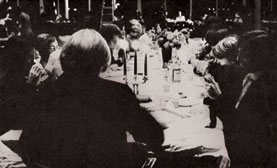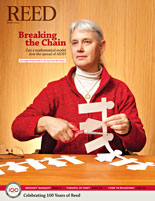
IRIS login | Reed College home Volume 91, No. 1: March 2012
Beggars’ Banquet

Students reverse the social polarity of scrounging with candelabra and white linen at the Beggars’ Banquet of 1969.
I just read with interest “The Origin of the Scrounge.” I would like to add a few comments. I was a scrounger during the 1969–70 school year. I reluctantly became a scrounger because I’d spent my year’s school money on a motorcycle. I never heard it referred to as “the scrounge.” It was simply “scrounging” and I was a “scrounger.” Once my initial hesitation had passed, I discovered that it was the best way to enjoy a meal in Reed’s fine cafeteria. The trick was to develop a fan base. These were mostly women, because they tended to eat less. Each one would bring me one component of the meal, which they took but did not wish to eat—a vegetable, potatoes, main course, and dessert. I never had to touch half-eaten food. In fact, I ate better than those with meal tickets because I got to try everything.
At the time, there were between two and six scroungers. Toward the end of the school year, the number grew to about a dozen. There were two other things I remember about scrounging—we enjoyed the meals because we didn’t take them too seriously, and we all shared. No one went hungry. Also, we were very respectful of the kitchen crew and often helped them clean up. They returned this courtesy. On November 7, 1969, the kitchen crew set a table with white linen and candelabras in the middle of the dining hall. We found old tuxedos from the Goodwill shop and were served by the kitchen crew, who scrounged the food for us! It was called the Beggars’ Banquet, and, if you find the picture in your archives, I’m the second guy on the right.


LATEST COMMENTS
steve-jobs-1976 I knew Steve Jobs when he was on the second floor of Quincy. (Fall...
Utnapishtim - 2 weeks ago
Prof. Mason Drukman [political science 1964–70] This is gold, pure gold. God bless, Prof. Drukman.
puredog - 1 month ago
virginia-davis-1965 Such a good friend & compatriot in the day of Satyricon...
czarchasm - 4 months ago
John Peara Baba 1990 John died of a broken heart from losing his mom and then his...
kodachrome - 7 months ago
Carol Sawyer 1962 Who wrote this obit? I'm writing something about Carol Sawyer...
MsLaurie Pepper - 8 months ago
William W. Wissman MAT 1969 ...and THREE sisters. Sabra, the oldest, Mary, the middle, and...
riclf - 10 months ago